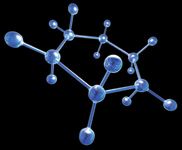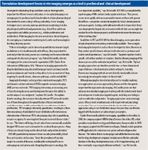Exploring Catalysis in API Synthesis
Chemocatalysis and biocatalysis are important elements of an effective strategy for improving yield and stereoselectivty.
Catalysis is a crucial part of organic chemistry as a tool to improve reaction conditions, yield, stereochemistry, and to make desired products. Research in catalysis involves not only the development and application of new catalysts in specific reactions, but also centers on gaining a better understanding of the molecular science of catalysis.

IMAGE: GETTY IMAGES
Catalyst screening
An important task in developing a chemical process is to identify the optimal catalyst by testing different metal and ligand combinations in various reactions. Combinatorial methods can be used in ligand synthesis to produce potential catalysts, and methods to screen potential catalysts are then needed. A group of Dutch researchers recently reported on using an approach that they dubbed, "the survival of the weakest," in which they used a selection method that focuses on the stability of the catalytic intermediate measured by electrospray mass spectrometry (1, 2). The researchers reported that the stability of the intermediate related inversely to the reactivity of the catalyst, which formed the basis of a catalyst-screening protocol in which less-abundant species represented the most-active catalysts. This screening method was used in the palladium-catalyzed allylic alkylation reaction using diphosphine and IndolPhos ligands (1).

Patricia Van Arnum
Green approaches
Catalysis also provides the opportunity to develop more sustainable chemical processes. Depending on the reaction, such benefits, for example, would allow for byproduct reduction, improving reaction conditions such as temperature and pressure, and achieving better atom efficiency through better transformations. N. Raveendran Shiju, a researcher at the University of Amsterdam's Heterogeneous Catalysis and Sustainable Chemistry Group, recently reported on a new catalyst for ammoximation reactions, according to a Feb. 26, 2010, university press release. The catalyst, which is suitable for the production of fine chemicals, pharmaceutical intermediates, and nylon, offers the potential for a more economically attractive and greener process for ammoximation.
The current industrial ammoximation processes can generate as much as 2.5 kilograms of waste for every kilogram of end product, according to the release. The new heterogeneous catalyst reduces the level of waste, is easier to make, and uses fewer chemical additives in the process. The new catalyst could possibly be used for the production of paracetamol as well as caprolactam and nylon. The researchers filed patents for the technology in the United States and European Union, according to the release. They are further studying the relationship between the structure and activity at the catalyst's surface to further optimize the process.
Researchers at the University of Scotland reported on a new approach for separating the reaction products from a catalyst in a homogeneous reaction. The researchers used rhodium complexes formed from triphenylphosphine ligands functionalized with weakly basic amidine groups as highly active catalysts for the hydroformylation of alkenes. The approach involves tagging the coordinated phosphine ligands with weakly basic amidine groups to give organic soluble catalysts for performing reactions such as the conversion of alkenes to aldehydes rapidly in a solvent such as toluene. Addition of water and bubbling carbon dioxide causes the catalyst, but not the product, to switch into the aqueous phase as the protonated bicarbonate salt. After phase separation and the addition of a new organic phase, the catalyst can be switched back into the organic phase for use in a repeat reaction by bubbling it through nitrogen at 60 °C. Losses of rhodium are minimal. The approach offers the potential of using more sustainable or less-energy intensive chemical processes (3, 4).
Heterogeneous catalysis
Better understanding of the molecular science of heterogeneous catalysts is an important part of research efforts in catalysis. Heterogeneous catalysts, which are in a different phase from that of the reactants, offer certain advantages compared with homogeneous catalysts, which are in the same phase as the reactants. Typically solids, heterogeneous catalysts can be more easily separated and recovered in a product stream and therefore lend themselves to continuous chemical processing. They are also generally more tolerant of extreme operating conditions than homogeneous catalysts (5).

Formulation development forum: in vivo imaging emerges as a tool in preclinical and clinical development
A challenge in heterogeneous catalysis, however, is that the materials used as heterogeneous catalysts can contain a distribution of particles and pores of different sizes. To better understand the function of the active site of a heterogeneous catalyst, three key elements need to be considered, according to a recent report by the Dutch National Research School Combination Catalysis Controlled by Chemical Design (NRSC-Catalysis). NRSC-Catalysis represents scientists from various disciplines from nine Dutch universities: the University of Amsterdam (UvA), University Amsterdam (VA), Delft University of Technology, Eindhoven University of Technology, University of Nijmegen, University of Groningen, Leiden University, Utrecht University, and the University of Twente. NRSC-Catalysis issued the report to highlight the advances in catalyst design and development made by the group and to offer a perspective on future research efforts (5).
Three elements that need to be considered in heterogeneous catalyst development are: the chemical nature of the active center (0.1-nm length scale) that controls the bond-breaking and bond-making action of the catalyst; the local environment such as its hydrophilic or hydrophobic nature and the stereochemistry that is affected by processes on nanometer-length scales; and the accessibility of active centers that affect local concentrations and the rate of transport of molecules (5).
Researchers at the University of California at Berkeley recently reported on a method for applying heterogeneous catalysts to known homogeneous catalytic reactions through the design and synthesis of electrophilic platinum nanoparticles (6). These nanoparticles were selectively oxidized by a hypervalent iodine species. They catalyzed a range of p-bond activation reactions previously only catalyzed through homogeneous processes (6). The importance of this method is that it shows the potential of using nanoparticles to develop novel catalytic reactions that were previously not accessible through heterogeneous catalysis (6, 7). The researchers also reported that the platinum polyamidoamine dendrimer-capped nanoparticles showed better activity and recyclability compared with larger, polymer-capped analogs (6, 7).
A widely used class of heterogeneous catalysts are zeolites, which are microporous crystalline solids with well-defined structures. They are used as solid-acid catalysts in petrochemical processing. They are also a helpful tool for better understanding the effects of the environment of the catalytically active site, such as the pore wall, solvents, ligands, and the interaction with adsorbates. The NRSC-Catalysis report points out that various molecular-synthesis techniques can be used to activate zeolites for other reactions such as selective oxidation or dehydrogenation (5).
One interesting application is the development of selective oxidation catalysts by incorporating single-site silsesquioxane clusters connected through a polymeric matrix embedded in the channels of a porous inorganic support. Silsesquioxane clusters are small molecular complexes of silica or alumina, which contain reactive-single site atoms with similar reactivity as the inorganic support of a heterogeneous catalyst (5).
The NRSC-Catalysis program is also developing new designs for microfluidics reactor systems, which can be used for producing well-defined nanoparticles that can be used in heterogeneous catalysts (6). The design of catalysts, carriers, and reactors are interrelated, and studying these interrelationships is an important research area of NRSC-Catalysis. For example, researchers at the University of Nijmegen have built nano-sized reactor architectures with the goal of constructing cell-like assemblies from amphiphilic block copolymers. They developed a procedure to encapsulate enzymes at specific locations in these capsule and have used these systems to perform cascade reactions (5).
Systems catalysis
The NRSC-Catalysis program is also advancing a systems approach to catalysis, which analyzes functional catalytic systems in which multiple molecular processes are combined and regulated to carry out a catalytic operation. The goal of systems catalysis is to combine homogeneous, heterogeneous, and biocatalytic methods. A potential advantage of a systems approach to catalysis is to create "one-pot" multiple component catalyst systems for multistep synthesis. Most traditional synthesis is performed sequentially by ending one reaction step and then proceeding to the next reaction step, which may involve solvent and temperature swaps, liquid–liquid extractions, product crystallization, chromatographic purification, distillation, the addition or removal of protecting groups, and the addition and removal of reagents and catalysts. A systems approach would allow for a more directed way of developing catalytic reaction sequences and one-pot multicomponent catalyst systems (5).
Asymmetric synthesis
Strategies in asymmetric synthesis is an area of ongoing interest, particularly in the production of pharmaceutical compounds. In 2009, researchers from the University of Bristol in the United Kingdom and the University of Gothenburg in Sweden reported findings from their work in palladium-based asymmetric catalysis. The key finding was structural and mechanistic information on Trost modular ligands (TMLs), which combine with palladium to form catalysts. TML-Pd catalysts are widely used in allylic substitution reactions (8, 9). Their new model involved two regiochemically distinct (NH) and (CO) locations for nucleofuge or nucleophile binding, which may have broad utility for understanding the selectivity in asymmetric allylic alkylation reactions catalyzed by select palladium complexes and related ligands (8, 9).
Patricia Van Arnum is a senior editor at Pharmaceutical Technology, 485 Route One South, Bldg F, First Floor, Iselin, NJ 08830 tel. 732.346.3072, pvanarnum@advanstar.com.
References
1. J. Wassenaar et al., Nat. Chem.2 (5), 417–421 (2010).
2. S. Borman, Chem. & Eng. News88 (14), 7 (2010).
3. S. Ritter, N. Becker, and T. Blair, Chem. & Eng. News 87 (51), 35–39 (2009).
4. S.L. Desset and D.J. Cole-Hamilton, Angew. Chem., Int. Ed. Engl. 48 (8), 1472–1474 (2009).
5. NRSC-Catalysis, Future Perspectives in Catalysis (Amsterdam), http://www.nrsc-catalysis.nl/files/media/scientific_reports/Future_perspectives_in_Catalysis.pdf, accessed Apr. 5, 2010.
6. D. Toste et al., Nat. Chem. 2 (1), 36–41 (2010).
7. M. Jacoby, Chem. & Eng. News 87 (49), 10 (2009).
8. S. Borman, Chem. & Eng. News 87 (24), 31–33 (2009).
9. G.C. Lloyd. J. Am. Chem. Soc ., 131 (8), 9945–9957 (2009).

Drug Solutions Podcast: A Closer Look at mRNA in Oncology and Vaccines
April 30th 2024In this episode fo the Drug Solutions Podcast, etherna’s vice-president of Technology and Innovation, Stefaan De Koker, discusses the merits and challenges of using mRNA as the foundation for therapeutics in oncology as well as for vaccines.
Pharmaceutical Tariffs Are Imminent: How Industry is Bracing for Impact
April 16th 2025On April 14, 2025, the Trump Administration launched a national security-driven investigation into pharmaceuticals, a move that will likely result in tariffs being placed on pharmaceutical drugs, ingredients, and other components that are imported from outside of the United States.
Drug Solutions Podcast: Applying Appropriate Analytics to Drug Development
March 26th 2024In this episode of the Drug Solutions Podcast, Jan Bekker, Vice President of Business Development, Commercial and Technical Operations at BioCina, discusses the latest analytical tools and their applications in the drug development market.